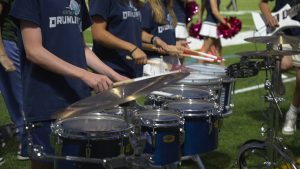Sailing faces headwinds at the regatta
Sailing team finishes in 4th place at Keelboat Qualifier
October 13, 2017
On Oct. 7, New Trier sailing competed in the Keelboat Qualifier, a regatta postponed for four hours due to heavy winds. Although it was admittedly not one of their best, they still came home with a fourth place finish out of the seven other competitors, including Evanston, University, Minnetonka, Traverse City, Hinsdale Central, Fall River, and Stillwater High Schools.
Last weekend’s regatta was one of many qualifiers, where the winner from each region of the United States advances to a regatta taking place later this year in Florida.
During this regatta, sailors competed in Sonars, which are 23 foot long keelboats, and sailed by four people. “They’re a lot of fun in lighter winds,” said sophomore Dylan Hardt.
Hardt mentioned one of the problems the sailors had were their starts. “We came too late to the starting line, and it set us back from the beginning,” said Hardt. Senior Ben Spring, who has been sailing his whole life, noted that the heavy winds that day were very challenging for the lightweight crew. Hardt agreed, saying that due to the heavy wind, they weren’t allowed to use their spinnakers.
Back at home, sailing practices at the Chicago Yacht Club, where they spend about an hour and a half, practicing drills and races on the water Tuesdays through Fridays. “On Fridays, instead of doing drills, we have ‘fleet race Fridays’ and we run a short regatta with the other high school sailors from Chicago Yacht Club to practice our racing skills,” explained junior Izzy Cox.
Another important aspect of their practices is their brief and debrief, according to junior Nathan Whisner. “In sailing, these lectures are critical to understanding strategy and tactics on the race course,” he said. Then, after practicing all week, sailors will usually attend a two day regatta on the weekend.
Boats are sailed with two people, a crew and a skipper. Crews sit in the front of the boat and control the front sail, which is called a jib, as well as the tilt of the boat, which is known as the heel. Similar to a coxswain in rowing, the crew is always updating the skipper on the wind and what the other boats on the racecourse are doing. The skipper’s job is to drive the boat with the rudder, control the main sail, and help the crew control the heel, especially when the wind is either very light or heavy.
Although sailing doesn’t involve a ball like most other sports, Cox stressed the importance of teamwork in sailing. “Good sailors work well with others and trust the other person in the boat. They are able to make informed, quick decision and adjust to changing conditions.” Cox also mentioned that sailing can be physically demanding, and so it is important that sailors are fit.
Sailing is one of the lesser known sports at school than others, such as lacrosse or football. However, there is an element to it that all New Trier sailors find particularly captivating. Many noted that they really enjoy sailing because of the varying weather conditions and all the different kinds of boats that make it so unpredictable and challenging.
“With the various sea states and weather come entirely new strategies and tactics to fit those conditions. I think that it is really cool to be so deeply ingrained in nature,” said Whisner, who learned how to sail from his dad when he was a kid, so the sport has been in his family for a while.
He explained that a good sailor has a deep understanding of the weather around them, and how that affects their boat. “They need the ability to make quick decisions and communicate effectively with the crew and have an advanced sense of strategy to guide them around the race course.”












































